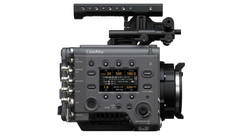A big highlight of this new firmware is variable frame rates, or Select FPS as Sony calls it, allowing recording from 1-60 fps in both 3.8K 16:9 and 4K 17:9 recording modes. And that's just the beginning – with this firmware update, we feel that VENICE is really firing on all cylinders. And its much earlier availability shows that, like the F55 camera before it, VENICE will truly be a platform that Sony will build on in the years to come. There's a ton of features and functionality in this update, so let's go through those that we think are the most important.
No less exciting than off-speed shooting is Sony's implementation of dual base ISOs on VENICE. When initially released, the camera supported a base ISO of 500 and an upper limit of 2000. In firmware 2.0, an additional base ISO of 2500 is now selectable from the Project --> Basic Settings menu (or via Project --> Project Settings --> Basic Settings from the Quick Menu). This new "high base" allows for high quality capture at previously "off limits" lighting levels for this class of camera, delivering an astonishingly clean picture at this setting and maxing out at a remarkable ISO 10,000.
A slew of new imager modes are also available in the new firmware. Now you can shoot in 4K 6:5 Anamorphic and, in the existing 4K 4:3 Anamorphic mode, both 25p and 29.97p are now supported with sync sound. For those with the 6K license, firmware 2.0 brings 1.85:1, 17:9, and 3:2 at 25p with sync sound. Playback of 6K 3:2 is now supported in-camera as well. Note that these are true imager modes, not simple aspect ratio markers or metadata, and will only record pixels within the frame size for a given AR.
Hidden behind the well-secured PL lens mount on the VENICE lies a locking full format (aka full frame) Sony E-mount, which is now fully enabled with firmware version 2.0. This will allow a whole universe of lenses, from the earliest days of handheld still and motion photography up through to the present, to be used with the camera. With its very short flange focal depth (also known as back focus distance or registration distance), the E-mount is likely the most adaptable full format lens mount ever made. Using appropriate adapters, virtually any lens with the power to cover the VENICE’s 24mm x 36mm VistaVision-sized sensor can be used. Including, of course, the latest native E-mount lenses such as Sony’s own G-Master series, the popular Loxia and Batis lenses from ZEISS, as well as Sigma's Art line (newly available in E-mount at this writing). Of course, higher-end glass, such as Zeiss' CP.3 and even their new Supreme line, are also available in native Sony E-mount as well. Lenses that make electronic contact with the E-mount can pass control signals and metadata to and from the camera.
User 3D LUTs also make their debut in this firmware, another welcome feature. User 3D LUTs allow you to take your personal film stock with you as a built-in part of the camera wherever you go, making VENICE more customized. Updated pre-installed MLUTs (monitor LUTs, for previewing EI ratings without affecting the underlying "negative") are available in the new firmware as well. For those waiting for the Custom Mode feature of older CineAlta cameras, such as the F5 and F55, it's scheduled to come to the VENICE in firmware 3.0; meanwhile, allowing you to create a custom look and "burn" it into the onboard recording is a great stopgap. Somewhat related to this, in as far as MLUTs and User 3D LUTs aid in setting exposure, is that false color has been added to the viewfinder display, making it possible to preview where on the luminance scale particular areas of the image will fall (such as a middle gray target).
Additionally, at the recent Cine Gear trade show in early June, Sony teased a future optional update for VENICE to support high speed/slow motion up to 60 fps in 6K, 90 fps in 4K and 120 fps in 2K. Word is this (likely paid) update will be available in Spring of 2019.
VENICE firmware 2.0 is available directly from Sony.


















